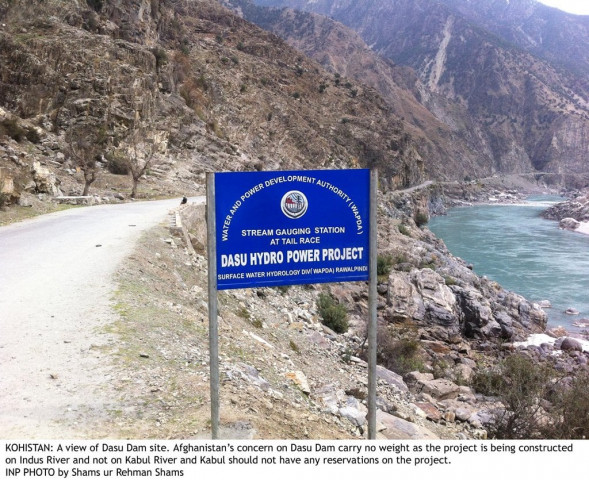A distant dream: Locals, officials lock horns over Dasu Hydel Project
Elders say WAPDA and administration failed to uphold its commitments.

A total of 30 resettlement sites were identified and finalised after consultations with affected villagers. The master plan and the survey of eight resettlement sites has already been completed. PHOTO: INP
The district administration and Water and Power Development Authorities (Wapda) may be trying their level best to resume construction of the much-trumpeted Dasu Hydropower Project (DHPP), but their differences with locals have proved to be a major hurdle.
Locals and official sources said work has been suspended for over 100 days in Dasu, the district headquarters of Kohistan. The main bone of contention is the rate at which their land is evaluated and the subsequent demand to be paid the said market rate.
The project encountered its first stumbling block on December 15, 2013 when Pakistan Muslim League-Nawaz (PML-N) MPA from Kohistan Abdul Sattar led protesters and had work forcibly stopped.
After the initial snag, work resumed on the project after Kohistani leaders agreed to hold negotiations with the administration. However, locals had work stopped on three different occasions since and construction finally came to a complete halt on September 21, 2014.

When money is in question
At the time, a tribal jirga issued a final warning to the administration and Wapda.
Locals demanded compensation for their lands which will be submerged by dam water, saying they should be paid market rates for the property. That was one of their 18 demands at the jirga.
They also wanted a job quota for locals, the construction of schools and colleges, a road network and resettlement colonies for the affected villagers. The district administration and Wapda officials failed to convince locals of the project even though they agreed to the demands.
“We are trying to convince landowners to allow the work to resume,” said an official at the office of Kohistan DC. The commissioner himself could not be reached.
The officer said the DC made repeated efforts to convince villagers through open meetings as part of his efforts to remove any obstacles in the path of this crucial project. The official added any obstruction would impede the government’s goal of ending the country’s power crisis.
“We are optimistic that positive news will emerge and high-level discussions are under way at the moment,” said Wapda project engineer Faqir Hussain. He added locals would feel an immediate improvement in their lives once work gets under way.
The engineer said the dam project would create employment opportunities, adding the construction of educational institutions, road networks and other facilities hinges on the resumption of work.
He said the project was of tremendous importance.
However, local elders such as Malik Manan Shah, Haji Samandar Khan, Malik Qadam Khan and others appear to be reluctant. The tribesmen said work would only resume once Wapda fully honoured their agreement.
The blue prints
According to official documents, the DHPP, being built seven kilometres upstream of Dasu on River Indus, will have a total installed capacity of 4,320 megawatts (MW).
It was proposed that the project be constructed in two stages. The first stage involves the installation of six units with a total installed capacity of 2,160 MW. The initial phase would also involve land acquisition, resettlement of affected people and environmental and social management.
The second stage includes installation of the remaining six units. The total cost of stage-I was estimated to be over Rs486 billion and the dam was scheduled to be completed in five years.
The World Bank Board of Directors approved $1,048 million as financing for stage-I of the DHPP, while the Executive Committee of National Economic Council (ECNEC), in its meeting held on March 28, 2014, approved the PC-I at Rs486 billion.
A total of 30 resettlement sites were identified and finalised after consultations with affected villagers. The master plan and the survey of eight resettlement sites has already been completed.
The Asian Development Bank has also expressed its willingness to fund a certain portion of the project, official sources said.
On June 25 last year, Prime Minister Nawaz Sharif inaugurated the DHPP.
Published in The Express Tribune, January 11th, 2015.













COMMENTS
Comments are moderated and generally will be posted if they are on-topic and not abusive.
For more information, please see our Comments FAQ